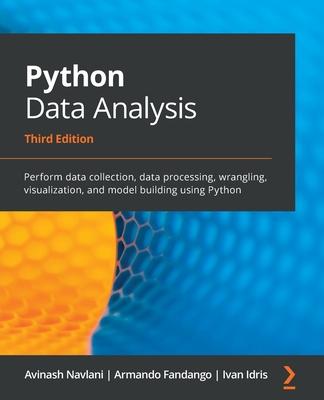Understand data analysis pipelines using machine learning algorithms and techniques with this practical guide
Key Features:
- Prepare and clean your data to use it for exploratory analysis, data manipulation, and data wrangling
- Discover supervised, unsupervised, probabilistic, and Bayesian machine learning methods
- Get to grips with graph processing and sentiment analysis
Book Description:
Data analysis enables you to generate value from small and big data by discovering new patterns and trends, and Python is one of the most popular tools for analyzing a wide variety of data. With this book, you'll get up and running using Python for data analysis by exploring the different phases and methodologies used in data analysis and learning how to use modern libraries from the Python ecosystem to create efficient data pipelines.
Starting with the essential statistical and data analysis fundamentals using Python, you'll perform complex data analysis and modeling, data manipulation, data cleaning, and data visualization using easy-to-follow examples. You'll then understand how to conduct time series analysis and signal processing using ARMA models. As you advance, you'll get to grips with smart processing and data analytics using machine learning algorithms such as regression, classification, Principal Component Analysis (PCA), and clustering. In the concluding chapters, you'll work on real-world examples to analyze textual and image data using natural language processing (NLP) and image analytics techniques, respectively. Finally, the book will demonstrate parallel computing using Dask.
By the end of this data analysis book, you'll be equipped with the skills you need to prepare data for analysis and create meaningful data visualizations for forecasting values from data.
What You Will Learn:
- Explore data science and its various process models
- Perform data manipulation using NumPy and pandas for aggregating, cleaning, and handling missing values
- Create interactive visualizations using Matplotlib, Seaborn, and Bokeh
- Retrieve, process, and store data in a wide range of formats
- Understand data preprocessing and feature engineering using pandas and scikit-learn
- Perform time series analysis and signal processing using sunspot cycle data
- Analyze textual data and image data to perform advanced analysis
- Get up to speed with parallel computing using Dask
Who this book is for:
This book is for data analysts, business analysts, statisticians, and data scientists looking to learn how to use Python for data analysis. Students and academic faculties will also find this book useful for learning and teaching Python data analysis using a hands-on approach. A basic understanding of math and working knowledge of the Python programming language will help you get started with this book.
